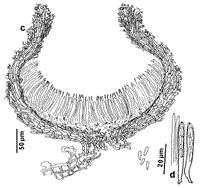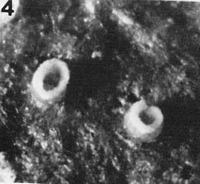|
 Crocicreas ilicifolium Crocicreas ilicifolium
BiostatusPresent in region - Indigenous. Endemic
Images (click to enlarge)
Caption: FIG. 1. c, d. Crocicreas ilicifolium (holotype). c. Vertical section through an apothecium. d.
Paraphyses, asci, and released ascospores. | 
Caption: FIG 4. Macroscopic appearance of apothecia (x 50), C. ilicifolium (holotype). |
Article: Johnston, P.R. (1989). Some tomenticolous Crocicreas species from New Zealand. Memoirs of the New York Botanical Garden 49: 108-111.
Description: Apothecia developing amongst tomentum of leaf on abaxial surface, in small necrotic patches
along margins of leaves, erumpent from leaf tissue. Apothecia 0.2-0.4 mm diam., sessile,
urceolate, receptacle pale-brown near base, margin white, pulverulent. Ectal excipulum up to
35 µm wide at sides of receptacle, comprising hyaline, cylindric, long-celled, 2-6 µm diam.
hyphae widely spaced and embedded in hyaline gel. Crystals scattered along the outside of
excipulum. Medullary excipulum extending to margin of receptacle; adjacent to and below the
hymenium up to 5 µm wide, comprising 2-3 rows of cylindric, hyaline, thin-walled,
nongelatinous, 1.5-2 µm diam. cells; above level of hymenium medullary cells pale-yellow,
each cell with several 2-7 µm long divarications. Asci 37-46 x 4-4.5 µm, cylindric, apex
rounded, apical pore amyloid, 8-spored. Ascospores 7-9 x 1.5-2 µm, tapering to base,
hyaline, nonseptate. Paraphyses 1.5-2 µm diam., tapering to more or less acute apex,
extending 5-10 µm beyond asci.
Notes: Etymology. ilicifolium, refers to host substrate.
NOTES. Divaricating medullary cells similar to those present in C. ilicifolium are also found
in C. macrostipitatum and C. epitephrum.
|